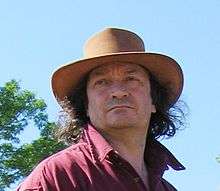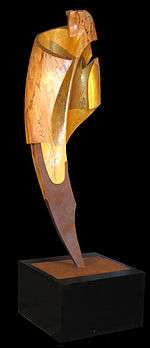Jean-Marc Tournois
| Jean-Marc Tournois | |
|---|---|
 | |
| Born | February 28, 1956 |
| Nationality | French |
| Known for | Sculptor |
Jean-Marc Tournois (French: [tuʁnwa]; born February 28, 1956) is a contemporary French artist. Stylistically the art of Tournois tends to be close to figurative abstraction. Tournois characteristically uses simplified shapes and forms, his themes include mythology, observations of nature (animals and plants) and human behavior.
Biography
Jean-Marc Tournois decided to turn his creativity to contemporary sculpture in the early 1980s. Tournois' inspiration by the abstract sculptures of Henry Moore and Constantin Brâncuși is clearly visible in his first bronzes, Piano and Dona. Both constitute milestones in his artistic development, casting future tendencies and an unmistakable signature of swinging proportions, harmonious asymmetry and elegant, flowing curves.
Jean-Marc Tournois is the author of a number of monumental sculptures that decorate the urban spaces of many European cities. In 1987 the city of Dijon (France) commissioned Heron. In 1988 the artist produced one of his best sculptures Jazz en Europe, now in Metz (France). Three years later the artist participated in the Biennale of the Foundation d'Entreprise Ricard, with his sculpture Chrysalide. The same year he completed Daioso, cut out of Burgundy limestone, for the town of Plombières-les-Dijon (France). In 1993 Tournois worked on Développement, a sculpture commissioned by the town of Anweiler (Germany). In 1994-1995 he took part in the Skulpturenweg public competition, funded by the state government of Rhineland-Palatinate. From this emerged two sculptures Ohne Titel (Untitled), in Herxheim, and Rätsel (Riddle), in Rodalben. Finally, in 1998 Tournois executed three bronze sculptures, Carnaval (Mâcon, France), Naïade,(Chevigny-Saint-Sauveur,France) and Jazz (Crans-Montana, Switzerland).
Before dedicating himself to sculpture Jean-Marc Tournois had worked as a designer on the sets of film productions such as Les amants du Pont-Neuf by Leos Carax (a five-meter high equestrian statue of Henry IV ), Grossesse nerveuse and La vie de Giacometti. His work in theatre included interior decorations at the Opéra Garnier and at the Théâtre de la Colline in Paris, as well as at theatres in Lille and in Marseille.
As a general rule the works of Jean-Marc Tournois are the product of a gathering effort ('assemblage') of thematic elements drawn from different sources (such as myths), all fused into one theme. Reconstructed and transformed, the original myths find their new connotations and meanings that correspond to our reality, and to a great extent to ourselves. In a way the artist works on the creation of 'an updated myth' or 'a new myth' which contains a range of coded messages accessible to the modern viewer. On viewing a sculpture one feels immediately drawn into the world of Tournois. The entire experience could be compared to that of a tease game with an element of derision. The viewer is puzzled, questions, and creates links with various visual and auditory associations; in other words he is more likely to look for answers within himself than outside. In this sense one can claim that Tournois encourages space for the privacy of one's thoughts and perceptions.

Mandragore
This sculpture is inspired by a myth about a magical plant and verses by François Villon (a 15th-century French poet). According to a medieval legend mandragore (or mandrake in English) grew uniquely under the gallows, from the semen of hanged criminals. For its roots' resemblance with the human body and also for its medicinal properties the plant was attributed various supernatural powers that associated it with witch-craft. Mandrake was often humanized in the sense that it could experience pain, produce sounds, etc. Although the sculpture is not a direct representation of the verses of François Villon, it reflects Tournois' own impressions of the beliefs and way of thinking of a medieval person. The verses give more or less clear picture of the perception of death as the natural ending of human life and the beginning of a new one. Life after death is closely linked to magic, and the mandrake myth is proof of such thought. The sculpture itself represents leaves (though the root is hidden in the ground) as if rejecting the negativity associated with the plant's roots. The sculpture gives the overall impression of lightness and growth - the triumph of life over death, continuity of life and artistic aspiration. In general the proportions of the sculpture resemble the human body - a reference to the original myth. One of the facets reveals the shape of a feather - a reference to the poet François Villon and his writings. Another facet, where the sculpture seems to be cut across from head to feet by a single line, reminds us of a blade or a sword on a pedestal. It is a reference to the harshness of life in medieval Europe. The combination of wooden structure and iron base refers to the contrast between this harshness and the sensitivity and tenderness of the verses of François Villon.

Corne de Brume
In English translation this French term means foghorn. The primary thematic material for this sculpture is a famous myth about Loreley - a legendary figure of the Rhine mythology that became a metaphor for fatal attraction. Loreley is a beautiful siren with golden hair who sits on the rock and enchants the ferrymen with her singing and murmuring, leading them towards their inevitable death. Tournois changes all the negative and sentimental context of this heartrending legend and gives it a new positive and even humoristic connotation. Thus Loreley is transformed into a foghorn whose primary role from now on is not to send boats to the bottom of the river, but to help them find their way around dangerous shipping obstacles. The function of the foghorn is represented symbolically in the form of a trumpet. Musical instruments or reference to music or sound is one of the most commonly used themes in the art of Tournois. The humoristic element of this sculpture are the thighs, which look grotesquely overdrawn when compared to other parts of the 'body' (although the artist himself admits that not every viewer had this impression). It is a witty hint as to the true nature of physical attraction and a slap in the face to a romanticised view of female beauty. The sculpture has the shape of a figurehead at the prow of a ship that breaks the waves. It is an important reference to nautical history in general as well as to life at sea - another world with its own myths and deities, its own rules and codes. In this sense the artist brings forward his own fascination with the sea, its eternal movement, force and freedom. The overall view of the sculptured figure of the Corne de Brume with a trumpet resembles the figures in triumphal scenes so common in 18th- and 19th-century painting. It is a reference to the celebration of life (a theme so common to the art of Tournois), to determination overcoming obstacles.
Volume and graphics
Tournois develops a particular approach to abstracting a figure, and this could be compared to the styles of Pompon and Brâncuși. His expression of volume in just a few lines and curves plays an essential role as it creates an essential link of communication to the primary idea of the sculpture. That is to say that the real essence of an object does not necessarily lie in its external form, but is found in its meaning and fundamental idea. What is more the depth of artistic conception does not require complexity of form, but simplicity. Volume represents a three-dimensional space that consists of many one-dimensional figures - lines. Before proceeding with a new sculpture the artist draws a sketch of a solid object to create a graphic illusion of a volumetric image by using simple lines. Later the artist eliminates the unnecessary lines and works only with those that best reveal the essence of the idea. The imagination of the viewer then completes the image, with missing lines creating new perceptions and interpretations.
- Conseil Régional de Bourgogne (éd.), 1895 - 1995 : 100 ans de cinéma en Bourgogne, 1995.
- Stadt Rodalben (Hg.), Internationales Bildhauer-Symposium Rodalben 1995, brochure, n.d.
- Kreisverwaltung Südliche Weinstrasse (Hg.), Internationales Bildhauer-Symposium Südliche Weinstrasse 16.5.-18.6.1994, brochure, n.d.
- Kultursommer Rheinland-Pfalz e.V. (Hg.), Skulpturenweg Rheinland-Pfalz - Kunst und Natur im Wechselspiel, brochure, 1998.